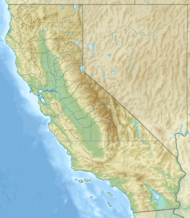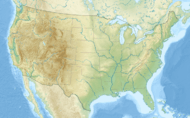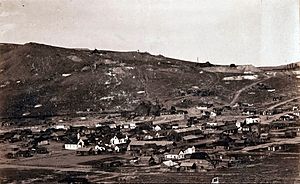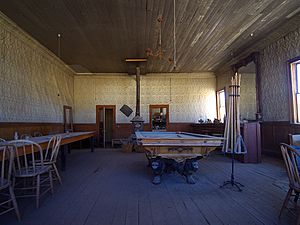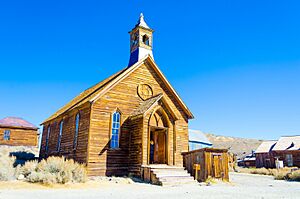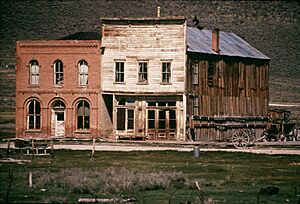Bodie, California facts for kids
Quick facts for kids
Bodie
|
|
|---|---|
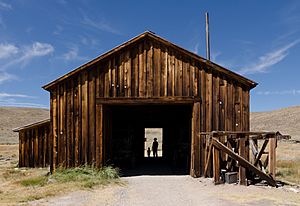
County Barn, Bodie, California
|
|
| Country | United States |
| State | California |
| County | Mono |
| Founded | 1876 |
| Elevation | 8,379 ft (2,554 m) |
| Population
(2020)
|
|
| • Total | 11 |
| Time zone | UTC−8 (Pacific) |
| • Summer (DST) | UTC−7 (PDT) |
| Area codes | 442/760 |
| Climate | Dsc |
| Website | Bodie State Historic Park |
|
Bodie Historic District
|
|
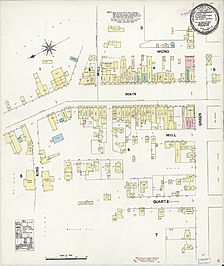
Map of Bodie, as of 1890
|
|
| Location | California |
| Nearest city | Bridgeport, California |
| Architectural style | Various; Southwestern U.S. frontier-style, late-19th to early-20th century. |
| NRHP reference No. | 66000213 |
| Significant dates | |
| Added to NRHP | October 15, 1966 |
| Designated NHLD | July 4, 1961 |
Bodie is a famous ghost town located in the Bodie Hills of Mono County, California. It sits east of the Sierra Nevada mountains. Bodie is about 75 miles (121 km) southeast of Lake Tahoe and 12 miles (19 km) east of Bridgeport. It is very high up, at an elevation of 8,379 feet (2,554 m).
Bodie became a busy "boom town" in 1876. This happened after a lot of gold was found there. By 1879, it had grown to about 2,000 buildings and was home to around 8,000 people.
Over the next few decades, the town slowly became less active. By 1915, people started calling it a ghost town. Today, the United States government recognizes the Bodie Historic District as a special National Historic Landmark.
Bodie is also a California Historical Landmark. In 1962, it officially became Bodie State Historic Park. About 200,000 people visit Bodie every year. The Bodie Foundation helps to support the park.
Contents
Bodie's Gold Rush Story
How Gold Was Found
Bodie started as a small mining camp in 1859. A group of gold seekers, including a man named W. S. Bodey, found gold there. Sadly, Bodey died in a snowstorm in November of that year. He never saw the town that would be named after him grow. The town's name was first spelled in different ways. But after a painter made a sign that said "Bodie Stables," the name "Bodie" became official.
Gold was also found in other nearby towns like Aurora and Virginia City, Nevada. But at first, not many people were interested in Bodie. By 1868, only two companies had built mills to process gold, and both of them failed.
The Gold Boom Years
Everything changed in 1876. The Standard Company found a huge amount of gold-rich rock. This discovery quickly turned Bodie from a quiet camp into a lively "Wild West" boom town. Even more gold was found in the Bodie Mine in 1878. This brought many more hopeful people to the town. By 1879, Bodie's population grew to between 7,000 and 10,000 people. There were also about 2,000 buildings.
Some stories say Bodie was California's second or third largest city in 1880. However, the official census from that year shows this was not true. Between 1860 and 1941, the mines in Bodie produced gold and silver worth about $34 million. That would be about $85 million in 2021!
Bodie was at its busiest from late 1877 to late 1880. The town even had its own newspaper, The Standard Pioneer Journal of Mono County. It started as a weekly paper and then came out three times a week. A telegraph line was also built, connecting Bodie to other towns. People in California and Nevada thought Bodie would become as rich as the famous Comstock Lode. Many men came to Bodie hoping to strike it rich.
Gold from the town's nine mills was sent to Carson City, Nevada. It traveled through other towns like Aurora and Gardnerville. These shipments often had armed guards to protect the valuable metal. Once in Carson City, the gold went to the mint there or was sent to the mint in San Francisco.
Town Life and Buildings
As a busy gold mining town, Bodie had many things you would find in larger cities. It had a Wells Fargo Bank, four volunteer fire departments, and a brass band. There was also a railroad, a miners' union, several daily newspapers, and a jail. Main Street was a mile long and had 65 saloons. The town was known for its lively and sometimes wild atmosphere.
Bodie also had a Chinatown with hundreds of Chinese residents. It even had a Taoist temple.
The town had a cemetery and a mortuary on its edge. The mortuary is the only building made of thick red brick. This was likely to keep the temperature steady during very cold winters and hot summers. The cemetery has a section for the Miners Union. It also has a monument to honor President James A. Garfield. The Bodie Boot Hill, where some people were buried, was outside the main cemetery.
On Main Street, you can still see the Miners Union Hall. This building was a meeting place for workers. It was also a fun place for dances, concerts, plays, and school shows. Today, it is a museum.
A Changing Mining Town
By 1880, Bodie started to change. New gold discoveries in places like Butte, Montana and Tombstone, Arizona drew many miners away. The single miners who came to get rich quickly moved on. Bodie then became more of a family town. In 1882, people built a Methodist Church (which is still standing) and a Roman Catholic Church (which burned down in 1928). Even with fewer people, the mines were still doing well. In 1881, Bodie's mines produced $3.1 million worth of ore.
Also in 1881, a special narrow-gauge railroad was built. It was called the Bodie Railway & Lumber Company. This railway brought wood and timber for the mines from Mono Mills, south of Mono Lake.
In the early 1890s, Bodie had a small comeback. New technology helped the mines keep going. In 1890, a new method called the cyanide process was invented. This process could get gold and silver from leftover mining waste and low-quality ore. In 1892, the Standard Company built its own hydroelectric plant. This plant was about 13 miles (21 km) away. It made electricity to power the company's mill. This was one of the first times electricity was sent over a long distance in the country.
By 1910, the town's population was 698 people. Most of these were families who chose to stay in Bodie.
Bodie's Decline
The first clear sign of Bodie's decline was in 1912. That year, the last Bodie newspaper, The Bodie Miner, stopped printing. In 1913, the Standard Consolidated Mine closed down.
Mining profits were very low in 1914, only $6,821. A man named James S. Cain bought many parts of the town and its mines. He reopened the Standard mill, and it made over $100,000 profit in 1915. But this boost was not enough to stop the town from shrinking. In 1917, the Bodie Railway was taken apart, and its metal tracks were sold for scrap.
The last mine in Bodie closed in 1942. This happened because of a government order during World War II. The order stopped all non-essential gold mining in the United States. Mining never started again after the war.
Bodie was first called a "ghost town" in 1915. Even though a fire damaged the business area in 1932, some people continued to live in Bodie for almost half of the 20th century. The post office in Bodie operated from 1877 to 1942.
A Ghost Town and Park Today
In the 1940s, people worried that vandals would damage the ghost town. The Cain family, who owned much of Bodie, hired caretakers to protect the buildings. Martin Gianettoni, one of the last three people living in Bodie in 1943, was one of these caretakers.
Today, Bodie is a real Wild West ghost town.
In 1961, Bodie was named a National Historic Landmark. In 1962, the state of California created Bodie State Historic Park. At that time, 170 buildings were still standing. Bodie has been named California's official state gold rush ghost town.
Most visitors come to Bodie using SR 270. This road starts from US 395 near Bridgeport. The last three miles of the road are dirt. There is also a very rough dirt road to SR 167 near Mono Lake. Because of heavy snow, the roads to Bodie are usually closed in winter.
Bodie is kept in a state of "arrested decay." This means the buildings are preserved as they are, but not fully restored. Only a small part of the original town remains, with about 110 structures still standing. This includes one of the old gold mills. Visitors can walk through the empty streets of what was once a very busy town. The insides of the buildings look just as they were left, with goods still on shelves. You might find small pieces of dishes or old bottles on the ground. However, it is against the law to take any items from the park.
The California State Parks' ranger station is in one of the original homes on Green Street.
In 2009 and 2010, Bodie was almost closed due to budget cuts. But the California state government found a way to keep it open. As of 2025, the park is still open and is managed by the Bodie Foundation.
Bodie's Climate
Bodie has a very unique climate. It has dry, hot to freezing summers and long, snowy winters. Winds can blow very fast across the valley, sometimes almost 100 miles per hour (160 km/h). Nights stay cold even in summer, often dropping below freezing all year.
On average, Bodie has 303 nights below freezing each year. No month has ever been completely free of frost. The fewest freezing nights in a month was two, in August 1967. The longest time without frost was only 30 days, from July 20 to August 18, 1901.
The weather is harsh because Bodie is very high up (8,400 feet or 2,560 meters). It is also on an open plateau with little protection from the wind and weather. People needed a lot of firewood to stay warm in winter. Since Bodie is not in a forest, wood had to be brought in from other towns. The winter of 1878–79 was especially cold and dangerous.
On average, there are 22.7 days with temperatures above 80°F (27°C). There are also 19.6 days where the temperature stays below freezing. And there are 35 nights with temperatures below 0°F (-18°C). The hottest temperature ever recorded was 91°F (33°C) on July 21, 1988. The coldest was -36°F (-38°C) on February 13, 1903.
Bodie gets about 11.79 inches (299 mm) of rain and snow each year. August is usually the driest month, and January is the wettest. On average, it snows about 93.2 inches (2.37 m) each year. The snowiest year was 1965, with 269 inches (6.83 m) of snow.
| Climate data for Bodie, California (1991–2020 normals, extremes 1895–present) | |||||||||||||
|---|---|---|---|---|---|---|---|---|---|---|---|---|---|
| Month | Jan | Feb | Mar | Apr | May | Jun | Jul | Aug | Sep | Oct | Nov | Dec | Year |
| Record high °F (°C) | 61 (16) |
63 (17) |
68 (20) |
77 (25) |
82 (28) |
90 (32) |
91 (33) |
89 (32) |
88 (31) |
81 (27) |
71 (22) |
64 (18) |
91 (33) |
| Mean maximum °F (°C) | 53.0 (11.7) |
53.4 (11.9) |
58.3 (14.6) |
66.4 (19.1) |
73.9 (23.3) |
81.2 (27.3) |
85.1 (29.5) |
83.6 (28.7) |
79.9 (26.6) |
72.9 (22.7) |
64.3 (17.9) |
54.0 (12.2) |
86.0 (30.0) |
| Mean daily maximum °F (°C) | 40.9 (4.9) |
41.1 (5.1) |
45.3 (7.4) |
51.0 (10.6) |
60.9 (16.1) |
70.8 (21.6) |
78.3 (25.7) |
77.5 (25.3) |
71.1 (21.7) |
60.8 (16.0) |
49.4 (9.7) |
40.9 (4.9) |
57.3 (14.1) |
| Daily mean °F (°C) | 24.2 (−4.3) |
24.9 (−3.9) |
29.0 (−1.7) |
34.9 (1.6) |
43.0 (6.1) |
51.3 (10.7) |
57.2 (14.0) |
55.5 (13.1) |
49.5 (9.7) |
40.3 (4.6) |
30.8 (−0.7) |
24.2 (−4.3) |
38.7 (3.7) |
| Mean daily minimum °F (°C) | 7.5 (−13.6) |
8.8 (−12.9) |
12.8 (−10.7) |
18.8 (−7.3) |
25.1 (−3.8) |
31.7 (−0.2) |
36.1 (2.3) |
33.6 (0.9) |
27.8 (−2.3) |
19.8 (−6.8) |
12.2 (−11.0) |
7.6 (−13.6) |
20.2 (−6.6) |
| Mean minimum °F (°C) | −15.0 (−26.1) |
−12.6 (−24.8) |
−7.8 (−22.1) |
2.9 (−16.2) |
10.5 (−11.9) |
15.6 (−9.1) |
22.5 (−5.3) |
20.5 (−6.4) |
14.0 (−10.0) |
2.9 (−16.2) |
−7.7 (−22.1) |
−14.1 (−25.6) |
−19.8 (−28.8) |
| Record low °F (°C) | −27 (−33) |
−36 (−38) |
−22 (−30) |
−13 (−25) |
−4 (−20) |
2 (−17) |
12 (−11) |
12 (−11) |
1 (−17) |
−13 (−25) |
−25 (−32) |
−31 (−35) |
−36 (−38) |
| Average precipitation inches (mm) | 1.79 (45) |
1.50 (38) |
1.31 (33) |
0.98 (25) |
1.14 (29) |
0.57 (14) |
0.63 (16) |
0.60 (15) |
0.22 (5.6) |
0.52 (13) |
0.96 (24) |
1.60 (41) |
11.82 (300) |
| Average snowfall inches (cm) | 17.4 (44) |
14.5 (37) |
22.3 (57) |
5.8 (15) |
4.5 (11) |
0.6 (1.5) |
0.0 (0.0) |
0.0 (0.0) |
0.1 (0.25) |
2.5 (6.4) |
10.6 (27) |
15.6 (40) |
93.9 (239) |
| Average extreme snow depth inches (cm) | 21 (53) |
25 (64) |
28 (71) |
16 (41) |
5 (13) |
0 (0) |
0 (0) |
0 (0) |
0 (0) |
2 (5.1) |
7 (18) |
14 (36) |
28 (71) |
| Average precipitation days (≥ 0.01 in) | 7.6 | 6.8 | 6.0 | 5.8 | 4.9 | 3.6 | 3.6 | 3.0 | 2.0 | 3.2 | 5.0 | 7.5 | 59 |
| Average snowy days (≥ 0.1 in) | 6.7 | 5.0 | 5.9 | 3.8 | 2.0 | 0.5 | 0.0 | 0.0 | 0.1 | 0.9 | 3.1 | 6.1 | 34.1 |
| Source: NOAA | |||||||||||||
Bodie in Books
- The children's novel Behind the Masks, by Susan Patron, is set in Bodie.
- Kathleen Haun's historical novel No Trees for Shade (2013) takes place in Bodie in 1880.
- Bodie is also a setting in the Kristiana Gregory book Orphan Runaways (1998).
See also
 In Spanish: Bodie para niños
In Spanish: Bodie para niños


